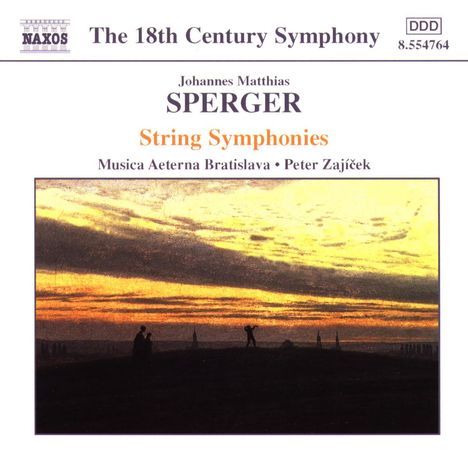Johannes Matthias Sperger: Streichersymphonien Nr.2 C-Dur, Nr.3 F-Dur, Nr.6 B-Dur auf CD
Streichersymphonien Nr.2 C-Dur, Nr.3 F-Dur, Nr.6 B-Dur
Herkömmliche CD, die mit allen CD-Playern und Computerlaufwerken, aber auch mit den meisten SACD- oder Multiplayern abspielbar ist.
Lassen Sie sich über unseren eCourier benachrichtigen, falls das Produkt bestellt werden kann.
- Künstler:
- Musica Aeterna Bratislava, Peter Zajicek
- Label:
- Naxos
- Aufnahmejahr ca.:
- 1992
- UPC/EAN:
- 0636943476420
- Erscheinungstermin:
- 12.2.2001
- Serie:
- Naxos 18th Century Classics
Ähnliche Artikel
Die drei hier enthaltenen Sinfonien sind alle dreisätzig und in diesen Fassungen für Streicher und Continuo instrumentiert. Die erste, die Sinfonie in C-Dur, bietet ein einleitendes Allegro im luziden Stil und in der Form der Epoche. Darauf folgt ein langsamer Satz, der als Andante bezeichnet wird und dessen allgemein hellere Stimmung mit einem Ausflug in die Molltonart kontrastiert, einer Wolke, die mit der Rückkehr des Eröffnungsmaterials bald vorüberzieht. Die Sinfonie endet mit einem Presto. Die Unisono-Eröffnung provoziert eine energische Antwort, während der Satz seinen schnellen und episodischen Verlauf nimmt.
Die Symphonie in F-Dur hat eine imposante Eröffnung mit einem dreiteiligen Satz in Sonatenform, der die üblichen Kontraste des Themas und einen relativ turbulenten zentralen Durchführungsteil aufweist. Der zweite Satz ist ein Menuett, das ein Trio umrahmt, das Änderungen der Textur erlaubt. Die Sinfonie endet mit einem Allegro, das in seinem gut ausgearbeiteten Verlauf Momente der Aufregung und Abwechslung bringt, eine Herausforderung an die Errungenschaften Mannheims.
Spergers Symphonie in B-Dur folgt in ihrem ersten Satz der heute etablierten Form, wobei sie dynamische Kontraste und Momente der Stille nutzt, mit Phrasenwechseln, die sofort als Teil der musikalischen Sprache der Zeit erkennbar sind. Sperger beginnt die zentrale Durchführung vorrangig mit einem Wechsel in eine Molltonart, bevor in der Reprise das erste Material wiederkehrt. Der zweite Satz ist ein Menuett in der traditionelleren Form, die ihre Verbindung zu dem Tanz, dem sie ihren Namen verdankt, beibehält. Ein zart pointiertes Trio bietet das notwendige Kontrast-Element. Der letzte Satz, der als Prestissimo bezeichnet wird, ist von einer gewissen Brillanz, ein angemessener Abschluss des gesamten Werks. Die wiederholte Exposition hat ihre eigenen dramatischen Akzente, die in der zentralen Durchführung noch verstärkt werden. Das Werk endet mit dem erwarteten Eklat.
Product Information
The three symphonies here included are all in three movements and scored, in these versions, for strings and continuo. The first, the Symphony in C major, offers an opening Allegro in the lucid style and form of the period. This is followed by a slow movement, marked Andante, its generally brighter mood contrasted with an excursion into the minor, a cloud that soon passes with the return of the material of the opening. The symphony ends with a Presto. The unison opening provokes an energetic reply, as the movement embarks on its rapid and episodic course.
The Symphony in F majorhas an imposing opening with a tripartite sonata-form movement that brings the usual contrasts of theme and a relatively turbulent central development section. The second movement is a Minuet, framing a Trio that allows changes of texture. The symphony ends with an Allegro that brings moments of excitement and variety in its well-crafted course, a challenge to the achievements of Mannheim.
Sperger's Symphony in B flat majorfollows what is now the established form in its first movement, making good use of dynamic contrasts and moments of silence, with turns of phrase that are instantly recognisable as part of the musical language of the time. Sperger follows precedent in starting the central development with a shift into a minor key, before the return of the first material in recapitulation. The second movement is a Minuet, in the statelier form that retains its association with the dance from which it takes its name. A delicately pointed Trio provides the necessary element of contrast. The last movement, marked Prestissimo, is one of some brilliance, an appropriate conclusion to the whole work. The repeated exposition has its own touches of drama and these are intensified in the central development. The work ends with the expected éclat.
Disk 1 von 1 (CD)
-
1 Symphony in C major: I. Allegro moderato
-
2 Symphony in C major: II. Andante
-
3 Symphony In C Major: Iii. Finale: Presto
-
4 Symphony in F major: I. Allegro moderato
-
5 Symphony in F major: II. Minuetto - Trio
-
6 Symphony In F Major: Iii. Finale: Allegro
-
7 Symphony in B flat major: I. Allegro con brio
-
8 Symphony in B flat major: II. Minuetto - Trio
-
9 Symphony In B Flat Major: Iii. Finale: Prestissimo
Mehr von Johannes Matthi...
-
Johannes Matthias SpergerKontrabasskonzerte Nr.2 & 15CDVorheriger Preis EUR 17,99, reduziert um 0%Aktueller Preis: EUR 7,99
-
Johannes Matthias SpergerKontrabasskonzerte Nr.1 & 8CDVorheriger Preis EUR 17,99, reduziert um 0%Aktueller Preis: EUR 7,99
-
Johannes Matthias SpergerStreichquartette op.1 Nr.1-3CDVorheriger Preis EUR 14,99, reduziert um 0%Aktueller Preis: EUR 7,99
-
Ernst von GemmingenViolinkonzerte Nr.1 & 2 (A-Dur & C-Dur)CDVorheriger Preis EUR 17,99, reduziert um 0%Aktueller Preis: EUR 7,99








